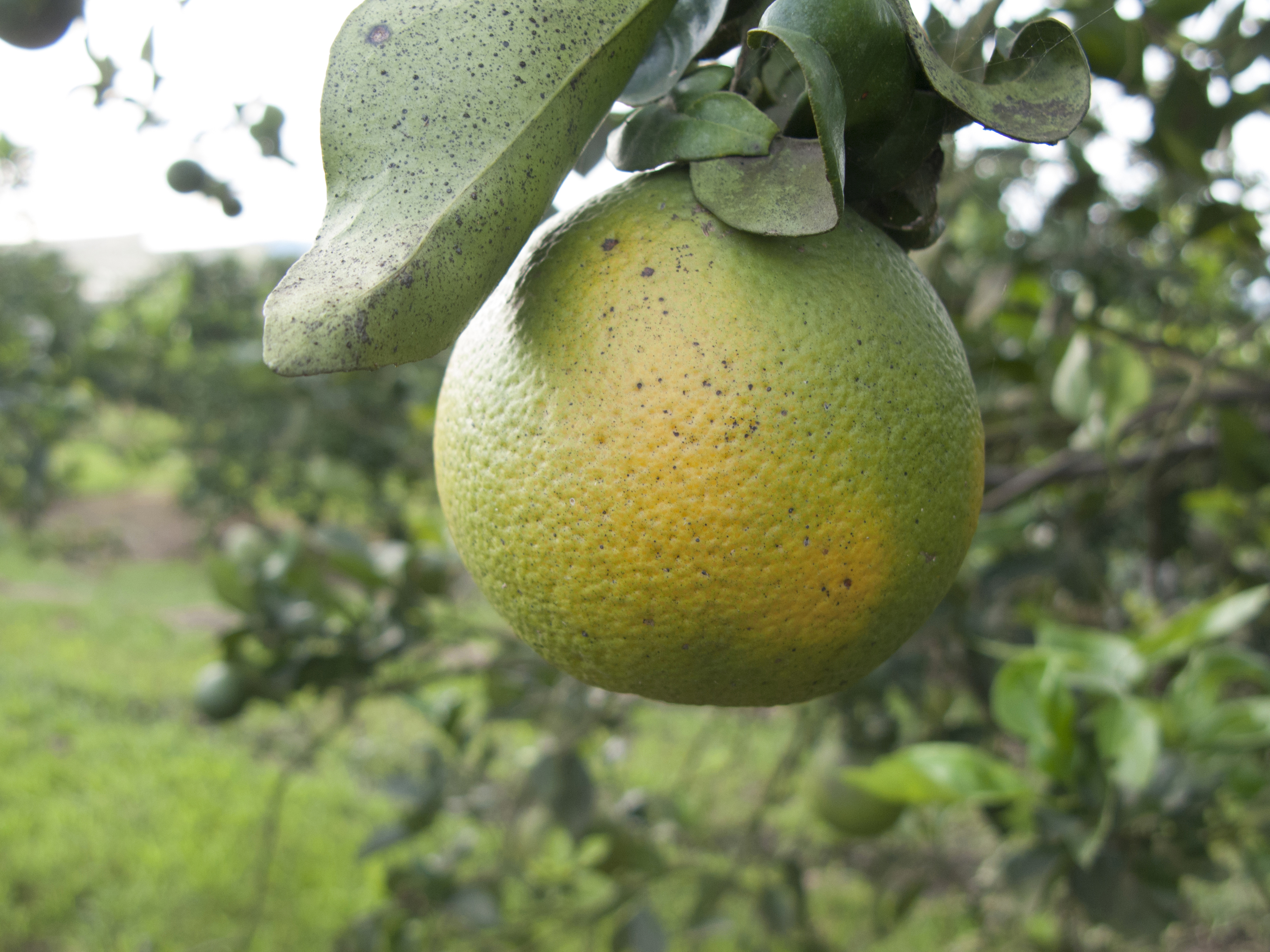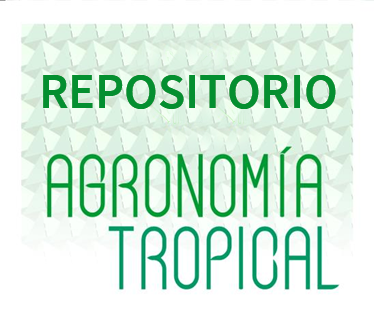El huanglongbing de los cítricos en Venezuela: distribución parcial e incidencia relativa de Candidatus liberibacter asiaticus en la región centro-norte
Resumen
El “Huanglongbing” (HLB) es actualmente la enfermedad más devastadora de los cítricos. Dos de las tres especies de bacterias que se asocian al HLB (Candidatus Liberibacter spp.), han sido encontradas en las Américas. En Venezuela, la especie ‘Ca. L asiaticus’ (CLas) fue detectada en 2017, aunque los síntomas tempranos característicos asociados a la enfermedad, tales como brotes amarillos fueron notificados por productores en varias regiones del país desde el año 2016. En este estudio, se colectó material vegetal proveniente de árboles de cítricos, así como de hospederos conocidos del HLB, en 17 municipios de los estados Aragua, Carabobo, Yaracuy y Portuguesa (Venezuela) entre Agosto y Noviembre de 2017, con el objetivo de determinar la incidencia relativa y el rango de hospederos de CLas en la región central del país. Las muestras fueron evaluadas mediante PCR, utilizando cebadores para amplificar la región del locus de las proteínas ribosomales en el operón-β de la bacteria. De un total de 113 plantas de cítricos sintomáticas, 87 (76.9 %) resultaron positivas para CLas. Adicionalmente, se encontraron plantas de Citrofortunella microcarpa, Murraya paniculata y Swinglea glutinosa (hospederas del vector del HLB, el psílido asiático de los cítricos, Diaphorina citri Kuwayama) infectadas con CLas en todos los estados incluidos en el estudio. Dado el porcentaje de infección que revela esta investigación, se recomienda realizar muestreos en los estados orientales y occidentales, a fin de conocer la diseminación e incidencia de la enfermedad en Venezuela y formular estrategias eficientes de manejo y control basadas en evidencia científica.
Descargas
Citas
• Bassanezi, RB; Lopes, SA; de Miranda, MP; Wulff, N; Volpe, HX; Ayres, AJ. 2020. Overview of citrus huanglongbing spread and management strategies in Brazil (online). Tropical Plant Pathology 45:251–264. Accessed Dec. 22, 2020. Available in https://doi.org/ghjzbx
• Bové, JM. 2006. Huanglongbing: a destructive, newly-emerging, century-old disease of citrus (online). Journal of Plant Pathology 88:7–37. Accessed Dec. 13, 2020. Available in https://bit.ly/3bmJrKD
• Cermeli, M; Morales, P; Godoy, F. 2000. Presencia del psílido asiático de los cítricos Diaphorina citri Kuwayama (Hemiptera: Psyllidae) en Venezuela. Boletín de Entomología Venezolana 15:235-243.
• Cifuentes-Arena, JC; Charles, GA; Peña, L; Lopes, SA. 2019. Murraya paniculata and Swinglea glutinosa as short-term transient hosts of ‘Candidatus Liberibacter asiaticus’ and implications for spread of Huanglongbing (online). Phytopathology 109:2054-2073. Accessed Dec. 18, 2020. Available in https://bit.ly/3bpq97h
• Cimò, G; Lo Bianco, R; González, P; Bandaranayake, W; Etxeberria, E; Syvertsen, JP. 2013. Carbohydrate and nutritional responses to stem girdling and drought stress with respect to understanding symptoms of Huanglongbing in citrus (online). Hortscience 48(7):920–928. Accessed Dec. 18, 2020. Available in https://bit.ly/3c7QwiH
• Coletta-Filho, HD; Daugherty, MP; Ferreira, C; Lopes, JRS. 2014. Temporal Progression of ‘Candidatus Liberibacter asiaticus’ Infection in Citrus and Acquisition Efficiency by Diaphorina citri (online). Phytopathology 104:416-421. Accessed Dec. 18, 2020. Available in https://doi.org/fzhh
• da Graça, JV; Douhan, GW; Halbert, SE; Keremane, ML; Lee, RF; Vidalakis, G; Zhao, H. 2016. Huanglongbing: an overview of a complex pathosystem ravaging the world’s citrus (online). Journal of Integrative Plant Biology 58(4):373-387. Accessed Dec. 14, 2020. Available in https://doi.org/f8jdhb
• Devi, EJ; Labala, RK; Modak, R; Singh, NS; Devi, HS. 2020. Molecular detection of “Candidatus Liberibacter asiaticus” causing HLB in Manipur and correlation of its incidence with elevation (online). Tropical Plant Pathology 45:658–667. Accessed 14, Dec. 2020. Available in https://doi.org/fzhf
• EFSA-PLH (European Food Safety Authority Panel on Plant Health, Italy). 2014. Scientific Opinion on pest categorization of Spiroplasma citri. EFSA Journal 12(2):3925. Accessed Jan. 6, 2021. Available in https://bit.ly/38HFe2h
• FEDEAGRO (Confederación de Productores Agropecuarios de Venezuela). 2020. Ubican en 90 % caída de la producción de cítricos en el país (online). Accessed Feb. 11, 2021. Available in https://bit.ly/3qsctwF
• Fermín, G; Briceño, A; Ely, F; Cedeño, L; Aranguren, Y; Valecillos, C. 2009. Citrus Cultivation in Venezuela. Tree and Forestry Science and Biotechnology 3(1):152-163.
• Fu, S; Bai, Z; Su, H; Liu, J; Hartung, JS; Zhou, C; Wang, X. 2019. Occurrence of prophage and historical perspectives associated with the dissemination of huanglongbing in mainland China. Plant Pathology 69(1):132-138. Accessed Dec. 22, 2020. Available in https://doi.org/fzhd
• Hernández, L; Ochoa, F; Derrick, K; Beretta, MJ; Cajon, O; Chacín, F; Machado, TW. 1993. Relación entre Xylella fastidiosa y el decaimiento repentino de los cítricos. Fitopatología Venezolana 6:42-43.
• Hocquellet, A; Toorawa, P; Bové, JM; Garnier, M. 1999. Detection and identification of the two Candidatus Liberobacter species associated with citrus huanglongbing by PCR amplification of ribosomal protein genes of the β operon (online). Molecular and Cellular Probes 13(5):373–379. Accessed Dec. 19, 2020. Available in https://doi.org/dv96bx
• Jagoueix, S; Bové, JM; Garnier, M. 1994. The phloem- limited bacterium of greening disease of citrus is a member of the α subdivision of the Proteobacteria (online). International Journal of Systematic and Evolutionary Microbiology 44:379–86. Accessed Dec. 16, 2021. Available in https://bit.ly/3ehxQhH
• Jenkins, DA; Hall, DG; Goenaga, R. 2015. Diaphorina citri (Hemiptera: Liviidae) abundance in Puerto Rico declines with elevation. Horticultural Entomology 108:252–258.
• Kim, JS; Sagaram, US; Burns, JK; Li, JL; Wang, N. 20 09. Response of sweet orange (Citrus sinensis) to ‘Candidatus Liberibacter asiaticus’ infection: Microscopy and Microarray Analyses. Phytopathology 99:(1)50-57.
• Lopes, SA; Bertolini, E; Frare, GF; Martins, EC; Wulff, NA; Teixeira, FC; Fernandes, NG; Cambra, M. 2009. Graft transmission efficiencies and multiplication of ‘Candidatus Liberibacter americanus’ and ‘Ca. Liberibacter asiaticus’ in citrus Plants. Phytopathology 99:301–306.
• Li, S; Wu, F; Duan, Y; Singerman, A; Guan, Z. 2020. Citrus Greening: Management Strategies and Their Economic Impact (online). HortScience 55:604-612. Accessed Jan. 7, 2021. Available in https://doi.org/fzhb
• Marys, E; Rodríguez-Román, E; Mejías, R; Mejías, A; Mago, M; Hernández, Y. 2020. First report on molecular evidence of Candidatus Liberibacter asiaticus associated with citrus Huanglongbing in Venezuela (online). Journal of Plant Pathology 102:1333. Accessed Dec. 13, 2020. Avalaible in https://doi.org/fn7j
• Morales, P; Schmidt A. 2016. Informe técnico sobre sospecha de HLB en muestras de plantas de naranja provenientes de ramas de árboles de naranja ‘Valencia’, Parcela 33 Colonia Guayabita. Instituto Nacional de Investigaciones Agrícolas, Centro Nacional de Investigaciones Agropecuarias. Gerencia de Investigación, Maracay. 8 p.
• Morales, P; Monteverde, E; Cermeli, M. 2020. La citricultura venezolana en tiempos del Huanglongbing. Visión actual y retos futuros (online). Agronomía Tropical 70:1-31. Accessed Feb. 6, 2021. Available in https://doi.org/fzg9
• Moreno, MJ; Belén, DR; García, D; Mendoza, L. 2006. Evaluación del contenido de carotenoides totales en cáscaras de algunas variedades de naranjas venezolanas. Revista de la Facultad de Agronomía-LUZ 23:301-309.
• Munir, S; He, P; Wu, Y; He, P; Khan, S; Huang, M; Cui, W; He, P; He, Y. 2018. Huanglongbing Control: Perhaps the End of the Beginning (online). Microbial Ecology 76:192. Accessed Jan. 7, 2021. Available in https://bit.ly/30lZHoS
• NCBI-BLAST (National Center for Biotechnology Information - Basic Local Alignment Search Tool, USA). 2020. Basic Local Alignment Search Tool (online, website). Accessed 06 ago. 2020. Available in https://bit.ly/311Cuc1
• Shen, W; Cevallos- Cevallos, JM; Nunes da Rocha, U; Arevalo, HA; Stanly, PA; Rober ts, PD; van Bruggen, AHC. 2013. Relation between plant nutrition, hormones, insecticide applications, bacterial endophytes, and Candidatus Liberibacter Ct values in citrus trees infected with Huanglongbing (online). European Journal of Plant Pathology 137:727–742. Accessed Dec. 20, 2020. Available in https://bit.ly/30pvaGw
• Singerman, A; Rogers, ME. 2020. The Economic Challenges of Dealing with Citrus Greening: The Case of Florida (online). Journal of Integrated Pest Management 11(3):1–7. Accessed Dec. 26, 2020. Available in https://bit.ly/3v2xaCK
• Spreen, TH; Baldwin, JP; Futch, SH. 2014. An Economic Assessment of the impact of Huanglongbing on citrus tree plantings in Florida. Hortscience 49(8):1052–1055.
• Tansey, JA; Vanaclocha, P; Monzo, C; Jones, M; Stansly, PA. 2017. Costs and benefits of insecticide and foliar nutrient applications to Huanglongbing- infected citrus trees (online). Pest Management Science 73:904 -916. Accessed Jan. 10, 2021. Available in https://bit.ly/38emA1V
• Teixeira, DDC; Danet, JL; Eveillard, S; Mar tins, EC; Junior, WCJ; Yamamoto, PT; Lopes, SA; Bassanezi, RB; Ayres, AJ; Saillard, C; Bové, JM. 2005. Citrus huanglongbing in São Paulo state, Brazil: PCR detection of the ‘Candidatus’ Liberibacter species associated with the disease (online). Molecular and Cellular Probes 19(3):173–179. Accessed Jan. 6, 2021. Available in https://bit.ly/3eiIc0
• Velásquez, A. 2007. Presencia del psílido de los cítricos (Diaphorina citri Kuwayama, Hemiptera: Psyllidae) en f incas productoras de cítricos en el estado Monagas. In Memorias del XX Congreso Venezolano de Entomología. (20, 2007, San Cristóbal, Venezuela). Universidad Nacional Experimental del Táchira. p. 177-178.
• Yuan, X; Chen, C; Bassanezi, R; Wu, F; Feng, Z; Shi, D; Du, Y; Zhong, L; Zhong, B; Lu, Z; Li, J; Song, X; Hu, Y; Ouyang, Z; Liu, X; Xie, J; Rao, X; Wang, X; Wu, D; Guan, Z; Wang, N. 2020. Region-wide comprehensive implementation of roguing infected trees, tree replacement, and insecticide applications successfully control citrus HLB (online). Phytopathology 1-29. Accessed Dec. 6, 2020. Available in https://bit.ly/3vG5qo4





